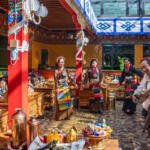A Timeless Tradition from the Heart of Tibet
Nestled in the picturesque landscapes of Shigatse’s Dingri County, the Dingri Lho-gzhas, colloquially known as the “Rural Circle Dance,” is a captivating form of folk dance deeply rooted in history. This dance, locally referred to as “Zhanian Xiaozhuo,” meaning “Zhanian-accompanied song and dance,” stands as a significant cultural hallmark of Dingri, showcasing the region’s rich artistic heritage and the influence of diverse cultures over the ages.
The Essence of Lho-gzhas: A Symphony of Song and Dance
The term Lho-gzhas, translating to “southern song and dance” in Tibetan, reflects the geographical and cultural essence of Dingri, historically referred to as “Lho” or the south. It represents a dynamic blend of singing and dancing, characterized by the unique use of “foot boots” to express emotions through rhythmic foot movements, with minimal upper body motion. This traditional dance encapsulates the essence of Dingri’s cultural identity, offering a window into the soul of its people.
A Rich Tapestry of Artistic Expression
Legend has it that Lho-gzhas encompasses over 108 types of melodies from both the upper and lower snow regions, each with numerous variations. This vast artistic repertoire signifies the dance’s versatility, adapting choreography to match the lyrics and melodies’ evolving tones. From labor songs to love duets, drinking songs to odes, Lho-gzhas covers a wide array of themes, mirroring the everyday lives and emotions of the Dingri people.
The Charm of Performance: An Artistic Fusion
At the heart of Lho-gzhas performances is the harmonious fusion of song, dance, and musical accompaniment, primarily featuring the Zhanian guitar and the Tibetan Jinghu. The performances are a feast for the senses, with men strumming and singing to the robust tunes of the Zhanian guitar, and women linking arms in graceful dance steps. This collective art form, rich in life and joy, promotes community participation and enjoyment, making it a cherished cultural activity.
Diverse Styles and Regional Variations
Geographically, Lho-gzhas can be divided based on the Pengqu River, with the southern Pazhu style and the northern Qiang-gzhas or Duoi-gzhas styles offering distinct musical and dance characteristics. Additionally, the dance style varies across different regions within Dingri, each with its unique contributions to the Lho-gzhas tradition, underscoring the rich cultural tapestry and historical depth of Dingri’s song and dance heritage.
Celebrating Dingri’s Cultural Legacy
Dingri Lho-gzhas is more than just a dance; it’s a vibrant expression of Tibetan culture, history, and community spirit. Its enduring appeal lies in its ability to bring people together, celebrating the rich tapestry of life through song and dance. As a treasure trove of artistic expression, Lho-gzhas continues to enchant and inspire, ensuring that the cultural legacy of Dingri thrives for generations to come.
In crafting this timeless tradition into a narrative, we aim to capture the essence of Dingri Lho-gzhas, making it accessible and engaging for a wider audience. Through simple, conversational English, we invite readers to explore the depth and beauty of this unique cultural phenomenon, celebrating the artistry and communal spirit that define the rural circle dance of Tibet.
The Evolution of Dingri Lho-gzhas: From Ancient Melodies to Modern Harmony
The Old vs. The New: A Dance of Two Eras
In the heart of Tibet’s rich cultural tapestry lies Dingri Lho-gzhas, a dance that beautifully encapsulates the spirit of its people. Interestingly, Lho-gzhas bifurcates into two distinct styles – the traditional “Tanglu” and the contemporary approach – each with unique musical instruments, vocal styles, and dance movements.
The Timeless Tanglu Tradition
Tanglu, the ancient faction of Lho-gzhas, holds a special place in the cultural landscape of Dingri. Characterized by its use of drums without the modern inclusion of the six-stringed guitar or the three-stringed Hu, Tanglu offers a slower tempo in both its melodies and dance steps. Its hallmark lies in the slow singing style, combined with vigorous running spins, leaps, and a distinctive musical timbre. This blend serves to express the lively and joyful essence of life in Tibet.
The Contemporary Wave
In contrast, the modern version of Lho-gzhas marks a departure from drum-based music, embracing the six-stringed guitar. This evolution introduced a novel approach to tuning, featuring a blend of high and low tones that complement the unique sounds of the three-stringed Hu. This instrument, peculiar yet harmonious with the local singing style, alongside the guitar, weaves into the Lho-gzhas, setting it apart as a unique art form.
Highlighting Achievements and Cultural Milestones
The journey of Lho-gzhas from a local tradition to a celebrated cultural emblem encompasses numerous milestones:
- Showcasing Talent: Xieger town’s 25 pastoral performers brought Lho-gzhas to the stage for the first time during the “Mount Everest Rainbow” performance in 2006, followed by appearances in Shanghai in 2007, and at the autonomous region’s Spring Festival Gala in 2008.
- National Recognition: In 2013, the group made an appearance on CCTV, securing a “Special Honors Award.” In 2015, they achieved the CCTV Tibetan Original Ecology Song and Dance “Gold Award,” proudly raising the cultural flag for Tibet.
- Cultural Heritage Status: On June 7, 2008, Dingri Lho-gzhas was honored as part of the second batch of national intangible cultural heritage by the State Council.
- Legacy Carriers: On May 8, 2018, Ouzhu, born in 1981 and a talented artist, was recognized as a representative inheritor of this national intangible cultural heritage, becoming a custodian of this rich cultural legacy.
- Celebrating Culture: Since 2005, Dingri County has hosted the annual “Mount Qomolangma Lho-gzhas Cultural Tourism Festival,” which has been held 18 times to date. The festival not only showcases Lho-gzhas performances but also features bonfire parties, Tibetan opera, and other folk arts, celebrating the vibrant culture of the region.
Conclusion: A Living Legacy
The evolution of Dingri Lho-gzhas from its ancient roots to its modern expressions reflects the dynamic nature of cultural traditions. As it moves forward, blending history with contemporary creativity, Lho-gzhas continues to stand as a testament to the resilience and vibrancy of Tibetan culture, bridging past and present through dance, music, and communal joy.
















